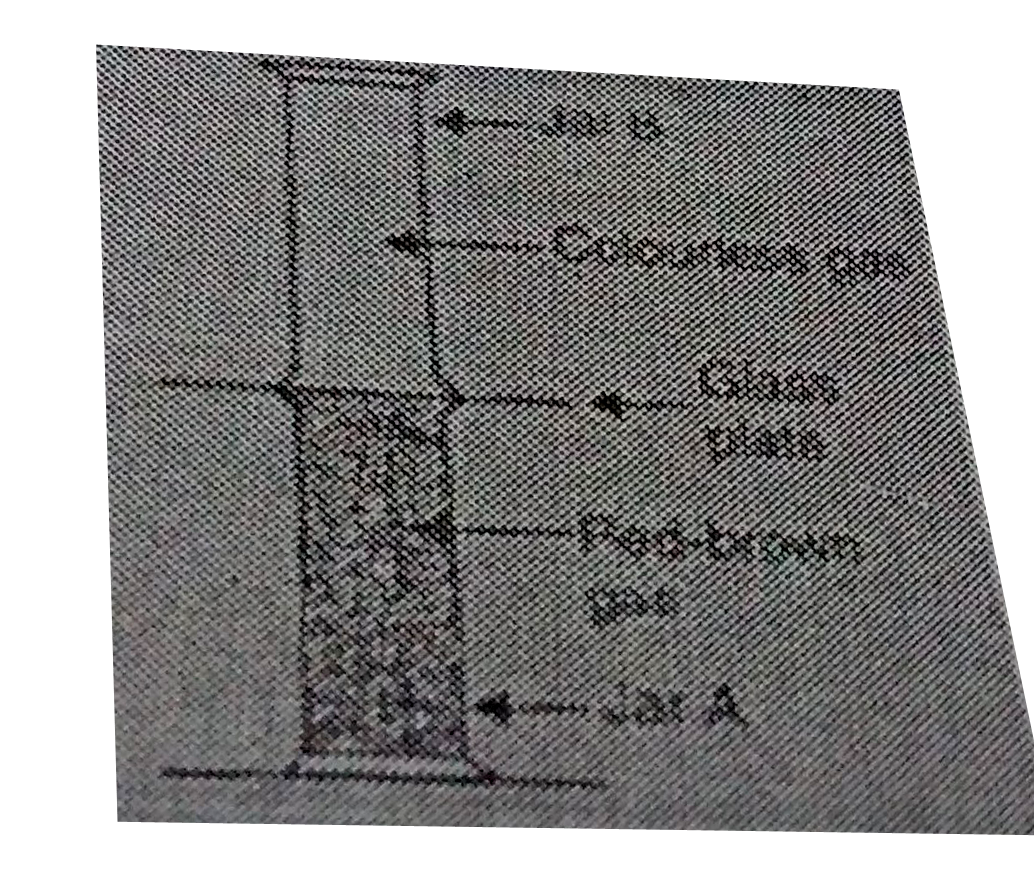The diagram shows the apparatus set-up for an experiment. Gas jar ( A) contains a brown gas, nitrogren dioxide and gas jar ( B) contains hydrogen > The molecular masses of nitrogen dioxide and hydrogen are 46 and 2 respectively.

Describe and explain the follwoing observations in the two gas jars as the experiment proceeds.
The speed of the gas particles.
The speed of the gas particles: Hydrogen is a lighter gas. It will diffuse than nitrogen dioxide.
Topper's Solved these Questions
- FOOTSTEPS TOWARDS(CBSE BOARD)Book:MTG IIT JEE FOUNDATIONChapter:FOOTSTEPS TOWARDS(CBSE BOARD)Exercise:SECTION-D
Explore 14 Videos
- FOOTSTEPS TOWARDS(CBSE BOARD)Book:MTG IIT JEE FOUNDATIONChapter:FOOTSTEPS TOWARDS(CBSE BOARD)Exercise:SECTION-B
Explore 11 Videos
- FOOTSTEPS TOWARDS (NEET)Book:MTG IIT JEE FOUNDATIONChapter:FOOTSTEPS TOWARDS (NEET)Exercise:QUESTIONS
Explore 44 Videos
- IS MATTER AROUND US PURE ?Book:MTG IIT JEE FOUNDATIONChapter:IS MATTER AROUND US PURE ?Exercise:OLYMPIAD/ HOTS CORNER
Explore 20 Videos
Similar Questions
The diagram shows the apparatus set-up for an experiment. Gas jar ( A) contains a brown gas, nitrogren dioxide and gas jar ( B) contains hydrogen > The molecular masses of nitrogen dioxide and hydrogen are 46 and 2 respectively.

Describe and explain the follwoing observations in the two gas jars as the experiment proceeds.
The colour of the gas.
View SolutionThe diagram shows the apparatus set-up for an experiment. Gas jar ( A) contains a brown gas, nitrogren dioxide and gas jar ( B) contains hydrogen > The molecular masses of nitrogen dioxide and hydrogen are 46 and 2 respectively.

Describe and explain the follwoing observations in the two gas jars as the experiment proceeds.
The amount of the gases in the gas jars.
View Solution
Knowledge Check
Equal volumes of hydrogen and oxygen gasses of atomic weights 1 and 16 respectively are found to exert equal pressure on the walls of two separate containers the ratio of rms speed of hydrogen and oxygen gas is
A1:4B4:1C1:32D32:1Two separate bulbs contain ideal gas A and B. The density of gas A is twice that of B. The molecular mass of A is half that of B. The two gases are at the same temperature. The ratio of pressure A to that of gas B is :
A2B12C4D12Two monoatomic ideal gases 1 and 2 of molecular masses m1 and m2 respectively are enclosed in separate containers kept at the same temperature. The ratio of the speed of sound in gas 1 to that in gas 2 is given by :-
A√m1m2B√m2m1Cm1m2Dm2m1
When a gas jar containing air is inverted over a gas jar containing bromine vapour, the red-brown bromine vapour diffuse into air. Explain how bromine vapour diffuse into air.
View SolutionLook at the diagram on the right side, jar A contains a red-brown gas whereas jar B contains a colourless gas. The two gas jars are separated by a glass plate placed between them

What will happen when the glass plate between the two jars is pulled away ?
What name is given to the phenomenon which takes place ?
Name the brown gas which could be in jar A.
(d) Which is the colourless gas most likely to be present in jar B ?
(e) Name one coloured solid and one colourless liquid which can show the same phenomenon
View SolutionIn a gas jar containing hydrogen chloride gas, a dry blur litmus paper is dropped. What change is observed ? Now a blur litmus paper is moistened and dropped into the gas jar. State what is observed and give a reason for this.
View Solution40 gm of compound containing 4 nitrogen atoms per molecules on combustion gives 2.8 gm of N2 gas.Molecular mass of compound is :
View SolutionTwo separate bulbs contain ideal gas A and B. The density of a gas A is twice that of a gas B. The molecular mass of A is half that of gas B. The two gases are at the same temperature. The ratio of the pressure of A to that gas B is
View Solution